ASP.NET MVC使用Identity增删改查用户
源码在这里:https://github.com/darrenji/UseIdentityCRUDUserInMVC,本地下载
在VS2013中创建一个MVC项目,用默认的"无身份验证"作为身份验证机制。
通过控制台下载Bootstrap。
Install-Package -version 3.0.3 bootstrap
下载成功后,在解决方案下的Content和Scripts多了该版本的css和js文件。
把创建项目默认HomeController中的所有Action以及/Views/Home下的所有视图删除。
热热身先来做一个简单练习。
在HomeController中的Index方法中,把一个字典传递给视图。
public class HomeController : Controller
{
public ActionResult Index()
{
Dictionary<string, object> data = new Dictionary<string, object>();
data.Add("placeholder", "placeholder");
return View(data);
}
}
_Layout.cshtml设置如下:
<head>
<meta http-equiv="Content-Type" content="text/html; charset=utf-8"/>
<meta charset="utf-8" />
<meta name="viewport" content="width=device-width, initial-scale=1.0">
<title>ASP.NET Identity实战</title>
<link href="~/Content/bootstrap.min.css" rel="external nofollow" rel="stylesheet" />
<link href="~/Content/bootstrap-theme.min.css" rel="external nofollow" rel="stylesheet" />
<style>
.container {padding-top:10px;}
.validation-summary-errors{color:red;}
</style>
</head>
<body>
<div class="container">
@RenderBody()
</div>
@Scripts.Render("~/bundles/jquery")
@Scripts.Render("~/bundles/bootstrap")
@RenderSection("scripts", required: false)
</body>
Home/Index.cshtml视图中:
@{
ViewBag.Title = "Index";
Layout = "~/Views/Shared/_Layout.cshtml";
}
<div class="panel panel-primary">
<div class="panel-heading">用户明细</div>
<table class="table table-striped">
@foreach (string key in Model.Keys)
{
<tr>
<th>@key</th>
<td>@Model[key]</td>
</tr>
}
</table>
</div>
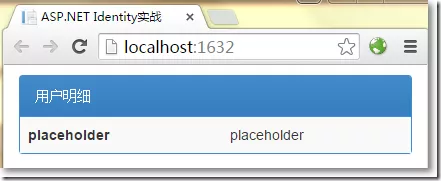
前期准备
分别安装如下组件。
Install-Package Microsoft.AspNet.Identity.EntityFramework –Version 2.0.0
Install-Package Microsoft.AspNet.Identity.OWIN -Version 2.0.0
Install-Package Microsoft.Owin.Host.SystemWeb -Version 2.1.0
配置Web.config如下:
<?xml version="1.0" encoding="utf-8"?>
<!--
有关如何配置 ASP.NET 应用程序的详细信息,请访问
http://go.microsoft.com/fwlink/?LinkId=301880
-->
<configuration>
<configSections>
<!-- For more information on Entity Framework configuration, visit http://go.microsoft.com/fwlink/?LinkID=237468 -->
<section name="entityFramework" type="System.Data.Entity.Internal.ConfigFile.EntityFrameworkSection, EntityFramework, Version=6.0.0.0, Culture=neutral, PublicKeyToken=b77a5c561934e089" requirePermission="false" />
</configSections>
<connectionStrings>
<add name="IdentityDb" providerName="System.Data.SqlClient" connectionString="Data Source=(localdb)\v11.0;Initial Catalog=IdentityDb;Integrated Security=True;Connect Timeout=15;Encrypt=False;TrustServerCertificate=False;MultipleActiveResultSets=True"/>
</connectionStrings>
<appSettings>
<add key="webpages:Version" value="3.0.0.0" />
<add key="webpages:Enabled" value="false" />
<add key="ClientValidationEnabled" value="true" />
<add key="UnobtrusiveJavaScriptEnabled" value="true" />
<add key="owin:AppStartup" value="WebApplication4.IdentityConfig" />
</appSettings>
<system.web>
<compilation debug="true" targetFramework="4.5" />
<httpRuntime targetFramework="4.5" />
</system.web>
<runtime>
<assemblyBinding xmlns="urn:schemas-microsoft-com:asm.v1">
<dependentAssembly>
<assemblyIdentity name="System.Web.Helpers" publicKeyToken="31bf3856ad364e35" />
<bindingRedirect oldVersion="1.0.0.0-3.0.0.0" newVersion="3.0.0.0" />
</dependentAssembly>
<dependentAssembly>
<assemblyIdentity name="System.Web.Mvc" publicKeyToken="31bf3856ad364e35" />
<bindingRedirect oldVersion="1.0.0.0-5.0.0.0" newVersion="5.0.0.0" />
</dependentAssembly>
<dependentAssembly>
<assemblyIdentity name="System.Web.Optimization" publicKeyToken="31bf3856ad364e35" />
<bindingRedirect oldVersion="1.0.0.0-1.1.0.0" newVersion="1.1.0.0" />
</dependentAssembly>
<dependentAssembly>
<assemblyIdentity name="System.Web.WebPages" publicKeyToken="31bf3856ad364e35" />
<bindingRedirect oldVersion="1.0.0.0-3.0.0.0" newVersion="3.0.0.0" />
</dependentAssembly>
<dependentAssembly>
<assemblyIdentity name="WebGrease" publicKeyToken="31bf3856ad364e35" />
<bindingRedirect oldVersion="0.0.0.0-1.5.2.14234" newVersion="1.5.2.14234" />
</dependentAssembly>
</assemblyBinding>
</runtime>
<entityFramework>
<defaultConnectionFactory type="System.Data.Entity.Infrastructure.SqlConnectionFactory, EntityFramework" />
<providers>
<provider invariantName="System.Data.SqlClient" type="System.Data.Entity.SqlServer.SqlProviderServices, EntityFramework.SqlServer" />
</providers>
</entityFramework>
</configuration>
以上,
增加了connectionStrings节点,将自动创建localdb数据库
在appSettings节点中增加了一个key为owin:AppStartup项,这是确保OWIN运行正常的全局配置
在Models文件夹下创建如下类。
public class AppUser : IdentityUser
{
}
在解决方案下创建Infrastructure文件夹。
在Infrastructure文件夹下创建一个上下文类,需要实现IdentityDbContext<>接口。
public class AppIdentityDbContext : IdentityDbContext<AppUser>
{
public AppIdentityDbContext()
: base("IdentityDb")
{
}
static AppIdentityDbContext()
{
//使用EF Code First第一次创建的时候调用
Database.SetInitializer<AppIdentityDbContext>(new IdentityDbInit());
}
public static AppIdentityDbContext Create()
{
return new AppIdentityDbContext();
}
}
//初始化
public class IdentityDbInit : DropCreateDatabaseIfModelChanges<AppIdentityDbContext>
{
protected override void Seed(AppIdentityDbContext context)
{
PerformInitialSetup(context);
base.Seed(context);
}
//初始化工作
public void PerformInitialSetup(AppIdentityDbContext context)
{ }
}
在Infrastructure文件夹下创建一个管理用户的类,需要继承UserManager<AppUser>类。
还记得,先前在appSettings节点中配置了一个如下方式:
<add key="owin:AppStartup" value="WebApplication4.IdentityConfig" />
OWIN需要一个全局启动文件,默认会到项目的顶级命名空间下找IdentityConfig这个类。
那就在App_Start中创建IdentityConfig这个类,这个类在WebApplication4这个命名空间下。
namespace WebApplication4
{
public class IdentityConfig
{
public void Configuration(IAppBuilder app)
{
app.CreatePerOwinContext<AppIdentityDbContext>(AppIdentityDbContext.Create);
app.CreatePerOwinContext<AppUserManager>(AppUserManager.Create);
app.UseCookieAuthentication(new CookieAuthenticationOptions {
AuthenticationType = DefaultAuthenticationTypes.ApplicationCookie,
LoginPath = new Microsoft.Owin.PathString("/Account/Login")
});
}
}
}
显示用户
创建AdminController,现在可以向视图传递所有的用户了,编写如下:
public class AdminController : Controller
{
public ActionResult Index()
{
return View(UserManager.Users);
}
private AppUserManager UserManager
{
get
{
return HttpContext.GetOwinContext().GetUserManager<AppUserManager>();
}
}
}
再创建Admin/Index.cshtml类型为IEnumerable<AppUser>的强类型视图。
@model IEnumerable<WebApplication4.Models.AppUser>
@{
ViewBag.Title = "Index";
Layout = "~/Views/Shared/_Layout.cshtml";
}
<div class="panel panel-primary">
<div class="panel-heading">
所有用户账户
</div>
<table class="table table-striped">
<tr><th>ID</th><th>Name</th><th>Email</th><th></th></tr>
@if (Model.Count() == 0)
{
<tr><td colspan="4" class="text-center">还没有创建用户</td></tr>
}
else
{
foreach (WebApplication4.Models.AppUser user in Model)
{
<tr>
<td>@user.Id</td>
<td>@user.UserName</td>
<td>@user.Email</td>
<td>
@using (Html.BeginForm("Delete", "Admin",
new { id = user.Id }))
{
@Html.ActionLink("编辑", "Edit", new { id = user.Id },
new { @class = "btn btn-primary btn-xs" })
<button class="btn btn-danger btn-xs"
type="submit">
删除
</button>
}
</td>
</tr>
}
}
</table>
</div>
@Html.ActionLink("创建用户", "Create", null, new { @class = "btn btn-primary" })
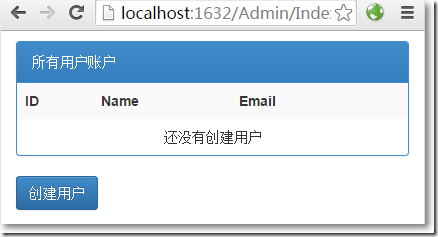
在Models文件夹下创建一个视图模型。
namespace WebApplication4.Models
{
public class CreateModel
{
public string Id { get; set; }
[Required]
public string Name { get; set; }
[Required]
public string Email { get; set; }
[Required]
public string Password { get; set; }
}
}
在AdminController中添加创建用户相关的方法。
public class AdminController : Controller
{
public ActionResult Index()
{
return View(UserManager.Users);
}
//创建显示
public ActionResult Create()
{
return View();
}
[HttpPost]
public async Task<ActionResult> Create(CreateModel model)
{
if(ModelState.IsValid)
{
var user = new AppUser{UserName = model.Name, Email = model.Email};
IdentityResult result = await UserManager.CreateAsync(user, model.Password);
if(result.Succeeded)
{
return RedirectToAction("Index");
}else{
AddErrorsFromResult(result);
}
}
return View(model);
}
//创建接收
private void AddErrorsFromResult(IdentityResult result)
{
foreach(var error in result.Errors)
{
ModelState.AddModelError("", error);
}
}
private AppUserManager UserManager
{
get
{
return HttpContext.GetOwinContext().GetUserManager<AppUserManager>();
}
}
}
在Admin/Create.cshtml视图页中:
@model WebApplication4.Models.CreateModel
@{
ViewBag.Title = "Create";
Layout = "~/Views/Shared/_Layout.cshtml";
}
<h2>Create</h2>
@using (Html.BeginForm())
{
@Html.AntiForgeryToken()
<div class="form-horizontal">
<h4>创建用户</h4>
<hr />
@Html.ValidationSummary(true)
<div class="form-group">
@Html.LabelFor(model => model.Name, new { @class = "control-label col-md-2" })
<div class="col-md-10">
@Html.EditorFor(model => model.Name)
@Html.ValidationMessageFor(model => model.Name)
</div>
</div>
<div class="form-group">
@Html.LabelFor(model => model.Email, new { @class = "control-label col-md-2" })
<div class="col-md-10">
@Html.EditorFor(model => model.Email)
@Html.ValidationMessageFor(model => model.Email)
</div>
</div>
<div class="form-group">
@Html.LabelFor(model => model.Password, new { @class = "control-label col-md-2" })
<div class="col-md-10">
@Html.EditorFor(model => model.Password)
@Html.ValidationMessageFor(model => model.Password)
</div>
</div>
<div class="form-group">
<div class="col-md-offset-2 col-md-10">
<input type="submit" value="创建用户" class="btn btn-default" />
</div>
</div>
</div>
}
<div>
@Html.ActionLink("返回", "Index")
</div>
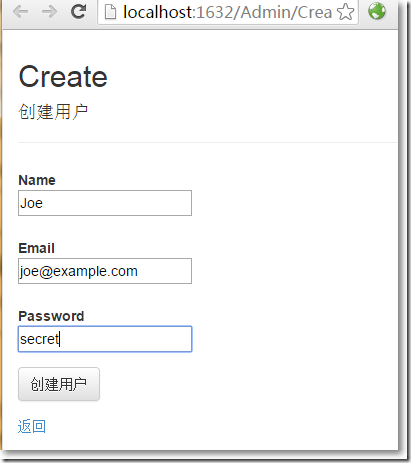
点击"创建"按钮,创建成功返回显示用户页面。

oh, my god,只是配置了一下就有数据了? 数据在哪呢?
点击左上角的"服务器资源管理器",右键"IdentityDb",点击"刷新"。
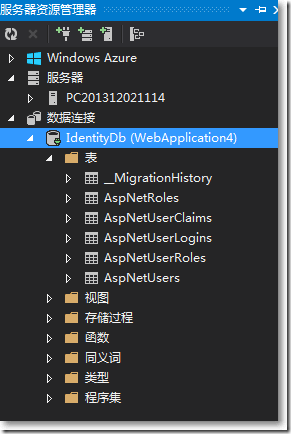
再打开AspNetUsers表,刚创建的用户赫然在列。

好像还有点欠缺,用户输入密码的时候,总应该有些限制吧。
能想到的,ASP.NET Identity都为我们准备好了。有一个PasswordValidator类就是干这个的。
在Infrastructure文件夹中创建一个PasswordValidator类的继承子类。
namespace WebApplication4.Infrastructure
{
public class CustomPasswordValidator : PasswordValidator
{
public override async Task<IdentityResult> ValidateAsync(string pass)
{
IdentityResult result = await base.ValidateAsync(pass);
if (pass.Contains("12345"))
{
var errors = result.Errors.ToList();
errors.Add("密码中包含太多连续数字");
result = new IdentityResult(errors);
}
return result;
}
}
}
然后需要把这个规则告诉UserManager。
namespace WebApplication4.Infrastructure
{
public class AppUserManager : UserManager<AppUser>
{
public AppUserManager(IUserStore<AppUser> store) : base(store) { }
public static AppUserManager Create(IdentityFactoryOptions<AppUserManager> options, IOwinContext context)
{
//identity ef上下文
AppIdentityDbContext db = context.Get<AppIdentityDbContext>();
//与identity ef相关的UserStore
IUserStore<AppUser> us = new UserStore<AppUser>(db);
AppUserManager manager = new AppUserManager(us);
//密码相关
manager.PasswordValidator = new CustomPasswordValidator {
RequiredLength = 6,
RequireNonLetterOrDigit = false,
RequireDigit = false,
RequireLowercase = true,
RequireUppercase = true
};
return manager;
}
}
}
再次运行程序,创建用户页面,尝试输入不通过的密码。
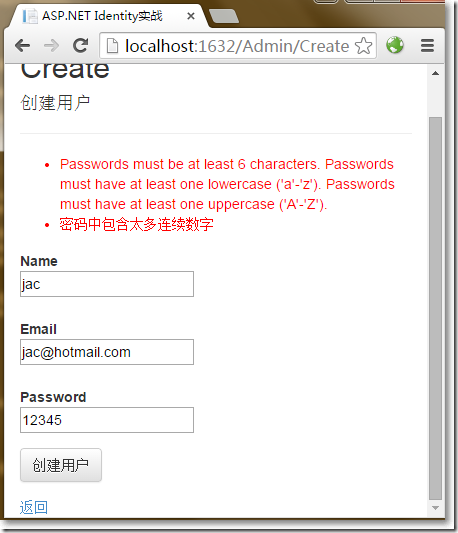
不过,关于密码的规则,似乎可以在View Model的验证层面就可以解决掉。
编辑和删除用户在AdminController中增加编辑和删除的部分。
public class AdminController : Controller
{
public ActionResult Index()
{
return View(UserManager.Users);
}
//创建显示
public ActionResult Create()
{
return View();
}
//创建接收
[HttpPost]
public async Task<ActionResult> Create(CreateModel model)
{
if(ModelState.IsValid)
{
var user = new AppUser{UserName = model.Name, Email = model.Email};
IdentityResult result = await UserManager.CreateAsync(user, model.Password);
if(result.Succeeded)
{
return RedirectToAction("Index");
}else{
AddErrorsFromResult(result);
}
}
return View(model);
}
//编辑显示
public async Task<ActionResult> Edit(string id)
{
AppUser user = await UserManager.FindByIdAsync(id);
if(User != null)
{
CreateModel createModel = new CreateModel();
createModel.Id = user.Id;
createModel.Email = user.Email;
createModel.Name = user.UserName;
createModel.Password = user.PasswordHash;
return View(createModel);
}
else
{
return RedirectToAction("Index");
}
}
//接收编辑
[HttpPost]
public async Task<ActionResult> Edit(CreateModel createModel)
{
if(ModelState.IsValid)
{
AppUser user = await UserManager.FindByIdAsync(createModel.Id);
if (user != null)
{
//关于邮箱
user.Email = createModel.Email;
IdentityResult validEmail = await UserManager.UserValidator.ValidateAsync(user);
if (!validEmail.Succeeded)
{
AddErrorsFromResult(validEmail);
}
user.UserName = createModel.Name;
//关于密码
IdentityResult validPass = null;
if (createModel.Password != string.Empty)
{
validPass = await UserManager.PasswordValidator.ValidateAsync(createModel.Password);
if (validPass.Succeeded)
{
user.PasswordHash = UserManager.PasswordHasher.HashPassword(createModel.Password);
}
else
{
AddErrorsFromResult(validPass);
}
}
user.Email = createModel.Email;
//验证结果
if ((validEmail.Succeeded && validPass == null) || (validEmail.Succeeded
&& createModel.Password != string.Empty && validPass.Succeeded))
{
IdentityResult result = await UserManager.UpdateAsync(user);
if (result.Succeeded)
{
return RedirectToAction("Index");
}
else
{
AddErrorsFromResult(result);
}
}
else
{
ModelState.AddModelError("", "无此用户");
}
}
return View(createModel);
}
else
{
return View(createModel);
}
}
//删除
[HttpPost]
public async Task<ActionResult> Delete(string id)
{
AppUser user = await UserManager.FindByIdAsync(id);
if(user != null)
{
IdentityResult result = await UserManager.DeleteAsync(user);
if(result.Succeeded)
{
return RedirectToAction("Index");
}
else
{
return View("Error", result.Errors);
}
}
else
{
return View("Error", new string[] { "没有此用户" });
}
}
private void AddErrorsFromResult(IdentityResult result)
{
foreach(var error in result.Errors)
{
ModelState.AddModelError("", error);
}
}
private AppUserManager UserManager
{
get
{
return HttpContext.GetOwinContext().GetUserManager<AppUserManager>();
}
}
}
Admin/Edit.cshtml视图。
@model WebApplication4.Models.CreateModel
@{
ViewBag.Title = "Edit";
Layout = "~/Views/Shared/_Layout.cshtml";
}
<h2>Edit</h2>
@using (Html.BeginForm())
{
@Html.AntiForgeryToken()
<div class="form-horizontal">
<hr />
@Html.ValidationSummary(true)
@Html.HiddenFor(model => model.Id)
<div class="form-group">
@Html.LabelFor(model => model.Name, new { @class = "control-label col-md-2" })
<div class="col-md-10">
@Html.EditorFor(model => model.Name)
@Html.ValidationMessageFor(model => model.Name)
</div>
</div>
<div class="form-group">
@Html.LabelFor(model => model.Email, new { @class = "control-label col-md-2" })
<div class="col-md-10">
@Html.EditorFor(model => model.Email)
@Html.ValidationMessageFor(model => model.Email)
</div>
</div>
<div class="form-group">
@Html.LabelFor(model => model.Password, new { @class = "control-label col-md-2" })
<div class="col-md-10">
@Html.EditorFor(model => model.Password)
@Html.ValidationMessageFor(model => model.Password)
</div>
</div>
<div class="form-group">
<div class="col-md-offset-2 col-md-10">
<input type="submit" value="保存" class="btn btn-default" />
</div>
</div>
</div>
}
<div>
@Html.ActionLink("返回", "Index")
</div>
另外,如果删除失败,跳转到Shared/Error.cshtml视图页。
@model IEnumerable<string>
@{ ViewBag.Title = "Error";}
<div class="alert alert-danger">
@switch (Model.Count())
{
case 0:
@: Something went wrong. Please try again
break;
case 1:
@Model.First();
break;
default:
@: 发现如下错误:
<ul>
@foreach (string error in Model)
{
<li>@error</li>
}
</ul>
break;
}
</div>
@Html.ActionLink("确定", "Index", null, new { @class = "btn btn-default" })
至此,使用ASP.NET Identy实现对用户的增删改查完毕,ASP.NET Identity真的很好很强大!
以上就是这篇文章的全部内容了,希望本文的内容对大家的学习或者工作具有一定的参考学习价值,谢谢大家对软件开发网的支持。如果你想了解更多相关内容请查看下面相关链接